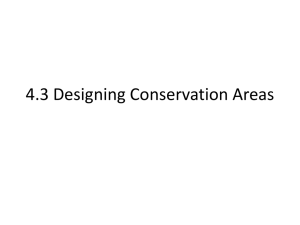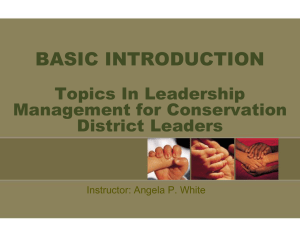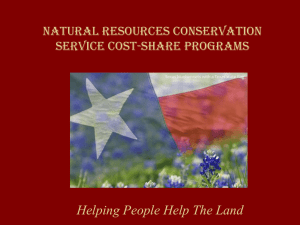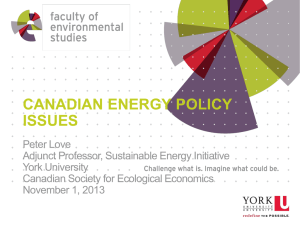Western Riverside MSHCP Landscape Level Conservation
advertisement
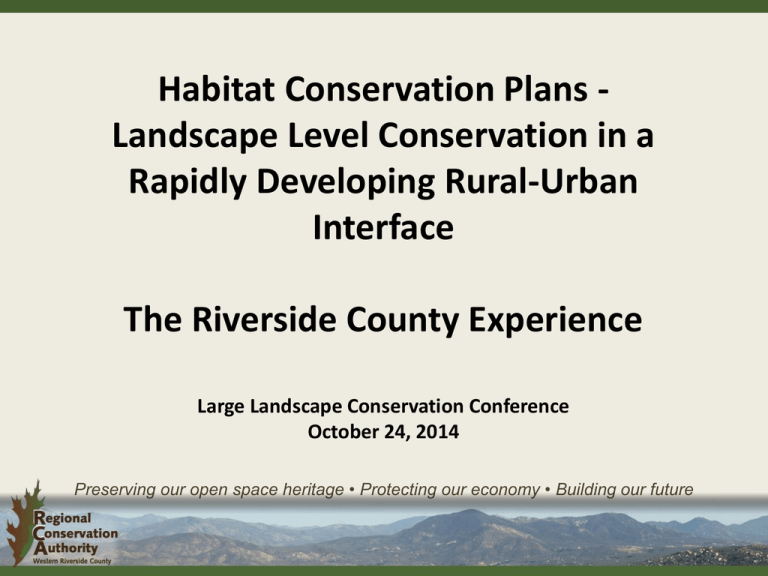
Habitat Conservation Plans Landscape Level Conservation in a Rapidly Developing Rural-Urban Interface The Riverside County Experience Large Landscape Conservation Conference October 24, 2014 Preserving our open space heritage • Protecting our economy • Building our future Why a Habitat Conservation Plan (HCP)? • • • • • • • Advanced Mitigation is provided for infrastructure Needed infrastructure is able to be placed Open space is not fragmented Development is not fragmented Habitat is not slowly strangled by cumulative edge effects The most effective way to deal with thousands of parcels Provides buy-in from diverse stakeholders • Certainty in preservation • Certainty in development Habitat Conservation Plans There are over 400 Habitat Conservation Plans nationwide, most are single species There are approximately Two dozen HCPs completed In California Western Riverside County Regional Conservation Authority* Mission: To establish a 500,000 acre habitat reserve to protect, restore and enhance habitats for 146 species of native plants and animals in western Riverside County, in order to support the placement of needed infrastructure *A Joint Powers Authority, administered by the County and Cities History - Riverside County Integrated Project • Initiated by the Riverside County Board of Supervisors • Recognition that land use and infrastructure decisions were driven by environmental issues, especially endangered and threatened species rules • Addresses environmental issues as a component of land use and infrastructure planning • Buy-in from diverse stakeholder groups; environmental, development, infrastructure, homeowners and others in a conservative county • Three part integrated program the Riverside County Integrated Project (RCIP) • Transportation • Land Use (General Plan) • Habitat Conservation (MSHCP) Multiple Species Habitat Conservation Plan •Linchpin to the Riverside County Integrated Project •Adopted in June 2003 •Permits issued in June 2004 •Supported by all 18 Western Riverside County Cities •Partners include: Caltrans, State Parks, Riverside County Transportation Commission, Flood Control District, Parks and Open-Space District “A plant to protect and sustain endangered and threatened animals and plants, and their habitats in a comprehensive way, so local governments can expedite the construction of infrastructure to support growthparticularly transportation facilities” Goals • Address cumulative impacts to biological resources to expedite infrastructure to serve growing region • Protect biological resources • Provide advanced mitigation for infrastructure projects within the plan • Provide flexibility in Reserve Assembly – thousands of parcels are affected • Provides local control of permitting process – Federal and State permits grant authority to “take” species What the MSHCP does • Allows all covered public infrastructure projects to proceed inside the Criteria Area • Allows all public and private projects outside the Criteria Area to proceed without delays associated with listed species • Compliance with the Plan provides all species related mitigation for project State CEQA documents • Allows hiking, horseback riding and other recreation on designated trails and designated areas The Basics • Seeks conservation of 500,000 acres - 347,000 acres already conserved (PQP) - 153,000 acres of Additional Reserve Lands (ARL) – acquired from private property owners • Covers “take” of 146 plant and animal species (33 are listed) • Criteria Based – no hard line maps - Conservation is described – as opposed to mapped to allow flexibility Public / Quasi-Public Conserved Lands Funding Sources • Shared acquisition: 2/3 Local, 1/3 State and Federal • Local Funding – Development mitigation fees – Landfill tipping fees – Infrastructure contribution – TUMF (5%), Measure A, Flood Control (3%), other (5% or per acre fee) – Other public facilities (libraries, parks, etc.) – Participating Special Entities (i.e., Utilities) • Federal Funding – Section 6 (HCP) only – Western Riverside Plan has no Refuge or Conservancy Management/Monitoring Management and monitoring stewardship is occurring on over 400,000 acres currently “To protect, restore and enhance habitats and the populations of native plants and animals of western Riverside County.” Monitoring Program A full time monitoring crew of biologists performs surveys throughout the year. All 146 species have had focused surveys conducted by the Monitoring Program or partnering agencies, and/or have been incidentally observed: • 8 year monitoring cycle – some species more frequently (annual or more) • A total of 141 of 146 species have been detected in the Conservation Area • Focused surveys by Monitoring Program have detected 130 species • Focused surveys have been conducted by partnering agencies for 3 additional species [e.g., SB flying squirrel (U.S. Forest Service)] • Another 8 species have been detected incidentally Spreading navarretia Granite spiny lizard Yellow-breasted chat White tailed kite Long-tailed weasel Challenges - RCA Funding Trends Totals Thru 10/09/2014 Funding Challenges $9,913,187 $9,385,012 $5,174,630 $6,284,238 $7,500,954 $7,217,933 $12,697,455 $22,439,770 $35,452,864 $25,975,060 • Issues - Required 100% Acquisitions must come first - Have to stay in Rough Step $40,000,000 $35,000,000 $30,000,000 - Development Pressures $25,000,000 - Limited Funding Availability $20,000,000 $15,000,000 $10,000,000 • Lessons $5,000,000 $- Prioritize acquisitions FY FY FY FY FY FY FY FY FY FY 2004 2006 2007 2008 2009 2010 2011 2012 2013 2014 & - Look for other partners 2005 - Be flexible within your priorities - Use any opportunities to acquire “gems” Other Lessons Learned • Even with highly successful plans, subjective interpretation of the plan will lead to conflict - Most plans are written as compromises • Revenue cycles may not be tied to plan requirements • A criteria-based plan requires extensive understanding of plan objectives - Flexibility is critical • Continuing to remind stakeholders why you made the plan is a must do - Newsletters, meetings Successes Local vs. Federal / State Funding Acres Conserved Total Acres Conserved 48,265 Funding Expended * Total Funding Expended $456,885,894 *Donation Values Included Totals Thru 10/9/2014 Additional Reserve Lands Major Plan Successes • Developed a comprehensive plan that ensures species habitat, development and infrastructure are holistically addressed • Stewardship of the Reserve is taking place on over 400,000 acres in compliance with the MSHCP • Acquired over 48,000 additional acres to date • Another 6,000+ acres has been conditioned through the land development process to come into the reserve • Facilitated Permittee projects, while restoring habitat, by using RCA properties for dozens of mitigation/restoration projects Major Policy Successes • Worked to provide a loan program for HCPs that support infrastructure – Loan program is now part of the Water Resources Development Act (WRDA) – Loan program language is currently in the Senate version of the new Transportation Bill • Federal Section 6 funding – Funding continues for HCP acquisition and planning Major Projects Expedited Under the MSHCP • • • • • • • • • New Metro link rail line Two new freeways Six major freeway widening projects Five major highway widening projects Over a dozen freeway and highway interchange projects Major dam remediation Five major power distribution projects Water distribution projects Dozens of local road improvements Questions? Charles Landry, Executive Director Western Riverside County Regional Conservation Authority clandry@wrcrca.org

